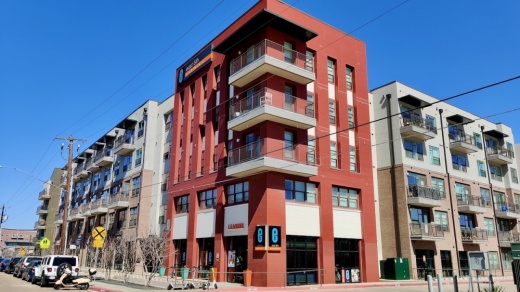The proposed changes to Austin's vertical mixed-use, or VMU, density bonus program passed through the Austin Planning Commission 8-1-2 March 22 after months of review by the city. The broadened VMU program concept was brought forward by District 5 Council Member Ann Kitchen and passed by council in the fall, and the commission also took on its own VMU review last summer.
In VMU-zoned areas, buildings with a mix of residential and commercial space are allowed benefits such as greater height if they provide a set percentage of affordable housing units in the development. The Kitchen-backed program expansion would keep the current VMU rules in place, renaming them as VMU1 while adding a new VMU2 category that could grant developers up to 30 feet of additional height for projects that add more affordable units or pay into city affordable housing funds.
According to city data, the VMU program had created 5,379 housing units as of February, including 540 available at an affordable level, across a total of 29 projects. Additionally, 6,029 units are under construction or in development across 27 planned projects, including 900 units that would be affordable.
The vast majority—at least 98%—of all units created under VMU are rental spaces. No spaces of any type have come through the VMU program in council districts 2, 6 and 8. A map of VMU zoning in Austin, including projects developed under the VMU program, can be viewed here. While council unanimously approved Kitchen's VMU2 concept in November, the final affordability details were left undecided until further review by city staff. That process was supposed to wrap up by late January but has stretched into the spring given "hiccups in the notification process," according to Erica Leak, a development officer with the city housing department.
The staff review produced recommendations that would increase the number of units required to be available at an affordable rate and at a lower level of affordability for developers to build under VMU2. Ownership developments such as condominiums would also have the option to pay fees in lieu of building new units. Staff report's on the VMU2 proposal, including affordability details, may be viewed here.
Commission review
The planning commission's vote for the VMU update took place after a debate over whether the commission would consider the code revision this month; the conversation began with several community requests for more time to look over the proposal.
City staff said notifications about the public hearing had been sent to neighborhood organizations in the required time frame, and the planning commission held its own public listening session on the changes last week. However, many speakers at the March meeting said the neighborhood groups needed more time to review proposed changes
Several commissioners agreed, although a vote to postpone the hearing until May failed 5-5-1. Commissioner Carmen Llanes Pulido referenced Austin's recent legal defeat over the issue of zoning notifications during the city's comprehensive land development code rewrite as a reason to be wary of pushing forward on the process this month.
"There’s a lot more public process that people want around this," Llanes Pulido said. "I think we need more time; we need to follow the public process. And there’s a lawsuit and a failed appeal by the city of Austin that shows that we need to follow the book with notification and protest rights."
Hearings on the code change will also be held once City Council takes the item up.
Once the commission's public hearing began March 22, a majority of residents at the meeting spoke in opposition to the VMU2 update. Community members noted wide-ranging concerns with VMU tied to rising residential costs, traffic, possible changes to existing compatibility rules, questions about city data and the presence of taller multifamily developments in historically single-family areas.
Michael Whellan, a land use attorney and the lone public speaker in favor of the VMU change and recommendations, advised the commission to move the code update along. However, he said additional focus is needed to address potential conflicts with existing compatibility requirements he said could hamstring the program and force a small slice of Austin property to do "a lot of heavy lifting" on affordability.
“Getting VMU2 right is critical for housing policy in Austin, and we cannot get VMU2 right unless we recognize the fact that compatibility makes VMU2 completely unachievable in many cases," Whellan said.
Other residents also expressed worries about a slate of six additional recommendations forwarded by a commission working group covering a broader range of issues than the VMU ordinance itself. Those items would seek further consideration of affordability, compatibility and the scope of the VMU program—although none would immediately change the VMU code update now moving along.
"We want to sort of signal to council that here’s the things we want them to think about, consider or give us further guidance on," Commissioner Awais Azhar said. "We’re not suggesting any amendments to the actual ordinance that we have in front of us.”
The VMU ordinance and five of six working group amendments only moved along after an extended discussion of the commission's process and duties as well as the merits of the changes. Both items passed after the commission split its vote between the less contentious VMU ordinance from staff and the working group's amendments they said are aimed at broadening the conversation.





